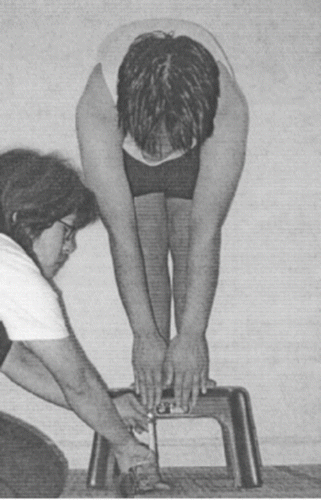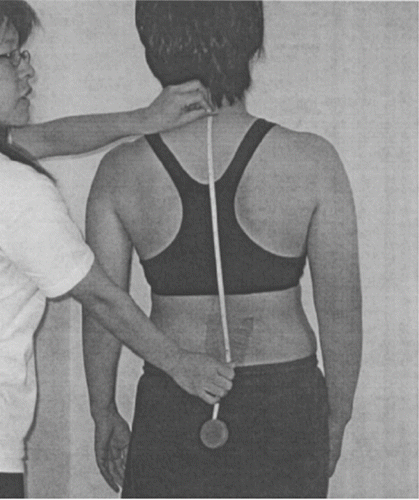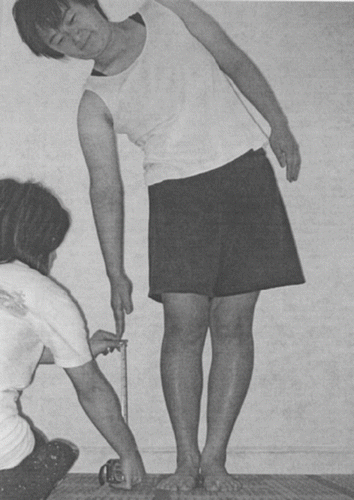Abstract
The purpose of the study was to determine the effects of kinesio taping (KT) on trunk flexion, extension, and lateral flexion. Thirty healthy subjects with no history of lower trunk or back issues participated in the study. Subjects performed two experimental measurements of range of motion (with and without the application of KT) in trunk flexion, extension, and right lateral flexion. A dependent t test was used to compare the range of motion measurements before and after the application of KT. Through evaluation of the sum of all scores, KT in flexion produced a gain of 17.8 cm compared with the non-kinesiotape group (t (29) = 2.51, p < 0.05). No significant difference was identified for extension (−2.9 cm; t (29) = −0.55, p > 0.05) or lateral flexion (3 cm; t (29) = −1.25, p > 0.05). Based on the findings, we determined that KT applied over the lower trunk may increase active lower trunk flexion range of motion. Further investigation on the effects of KT is warranted.
Lower trunk/back pain is a significant health problem contributing to a significant economic cost in the United States (CitationPai and Sundaram 2004). Approximately 85% of the U.S. population suffers at least one back injury or issue over a lifespan (CitationLively 2002). Many treatment methods exist including physical therapy, adjustable beds, ointments, and herbal remedies. Current treatments, however, have been shown to produce varying outcomes (CitationPai and Sundaram 2004). Kinesio tape, an alternative taping technique, has been theorized to improve a variety of physiological problems, including the range of motion, based on the functions of the tape (CitationKase 2001; CitationKase et al. 1996; CitationGarcia 2001; CitationGoo 2001; CitationHalseth et al., 2004; CitationMaruko 1999; Murray and Husk 2001; CitationOgura 1998; CitationOliveria 1999; Vochies 1999; CitationWallis 1999; CitationKase 1994; CitationKase et al. 2003). Currently research is lacking regarding the use of Kinesio tape as a viable option for increasing flexibility, specifically with back injury patients.
Injury prevention, treatment, and rehabilitation techniques in the United States have historically followed a Western medicine approach; the use of alternative treatments, such as KT recently has emerged as a viable option to treat athletic injuries. Kinesio tape is theorized to have several functions: (1) restoring correct muscle function by supporting weakened muscles, (2) reducing congestion by improving the flow of blood and lymphatic fluid, (3) decreasing pain by stimulating neurological system, and (4) correcting misaligned joints by retrieving muscle spasm (CitationKase 2001; CitationKase et al. 1996; CitationGarcia 2001; CitationGoo 2001; CitationHalseth et al. 2004; CitationMaruko 1999; Murray and Husk 2001; CitationOgura 1998; CitationOliveria 1999; Vochies 1999; CitationWallis 1999; CitationKase 1994; CitationKase et al. 2003). Kinesio tape is unique compared with other types of tape because the elasticity allows for elongation 130%–140% of its resting state and is approximately the same weight and thickness of skin (CitationKase 1994; CitationKase et al. 2003). Thus, KT has been theorized to be an effective treatment to restore muscle function and decrease pain (CitationKase et al. 1996; CitationGoo 2001; CitationMaruko 1999; Murray and Hosk 2001; CitationOgura 1998; CitationOliveria 1999; CitationVorhies 1999; CitationWallis 1999); however, a dearth of information exists regarding empirical evidence of efficacy in general, and specifically on the lower trunk. Therefore, the purpose of study is to determine the effects of KT on lower trunk flexion and extension and lateral flexion.
METHOD
The current study assessed the effect of kinesio tape on lower trunk flexion, extension, and right lateral flexion range of motion. Trunk range of motion was recorded before and after the application of kinesio tape. Thirty healthy subjects (15 females, average age 26.9 + −5.9; and 15 males, average age 20.9 + −12.1) voluntarily participated in the study. Subjects were eliminated if they had lower trunk injury or pain 6 months prior to the time of testing. The research protocol was approved by the Human Subjects-Institutional Review Board, and all participants signed an informed consent form prior to the experiment.
Procedures
Initially each participant was measured for trunk range of motion (ROM) using a tape measure. The same tape measurement procedure has been reported previously and has high levels of reliability with repeated measures (flexion: r = 98, extension: r = .96, lateral flexion: r = .98, ∗r = reliability; CitationFrost et al. 1982). Subjects performed a static stretch for 15 seconds in the three trunk motions that were tested for injury prevention purposes. For flexion, subjects stood on the stepstool with arms in a neutral position, heels together, and knees straight. Subjects bent forward as far as they could with fingers straight. The distance between the tip of third finger and the floor was measured (). For extension, subjects stood on the floor with arms in the neutral position, heels together, knees and back straight. Two landmarks were used to measure the range of motion of extension, the spinous process of C7 and the imaginary line between right and left posterior superior iliac spine. Subjects extend the lower trunk as far as they could, and the distance between two landmarks was measured (). For right lateral flexion, subjects stood on the floor with arms in the neutral position, heels together, knees and back straight. Subjects bent toward the right with elbow and fingers straight and attached hand on their lateral side of leg. The distance between the tip of third finger and the floor was measured ().
Range of motion was measured three times for reliability, before and after the application of Kinesio tape. A crossover design was used to eliminate the ROM taping routine as a variable. Kinesio tape was applied to 15 of the subjects after the end of three ROM measurements in the untaped status. The remaining 15 subjects performed three ROM measurements in the taped status first, followed by the untaped status. Subjects randomly were assigned in regard to the order of the two statuses.
Taping Method
Subjects were taped using a mthod proposed for the sarcospinaris muscle. Y-shaped (2-inch width and 11-inch length) tape was used in the study (; CitationKase 1994; CitationKase et al. 2003). The taping technique required subjects to stand erect while the origin of the Y-shaped taping technique was attached over the center of the sacrum. The origin of the Y tape was attached without stretching the kinsio tape while subjects gradually bent forward. The same procedure was applied to the other end of the Y tape. A 5-degree angle was maintained within the valley of the Y tape. The Y-shaped tape was applied from the origin of the sacrospinalis to the insertion as theorized to support a muscle function ().
A dependent t test was used to determine differences before and after the application of KT (CitationThomas and Nelson 2001). A dependent t test was used to assess two groups with the same subjects who were administered a pretest and a post-test. The average of the three trials for each ROM was computed for statistical analysis. T values for trunk ROM were computed to compare a t value of 1.699, which is the critical value for an alpha level of .05.
RESULTS
A significant difference was identified for trunk flexion ROM (). The taped condition in flexion was 17 cm higher than the untaped condition in the sum of all scores (t (29) = 2.51, P < .05). No significant differences were found for extension (−2.9 cm; t (29) = −0.55, p > .05) and lateral flexion (3 cm; t (29) = −1.25, p > .05).
Table 1. The Sum of All Scores (cm) Before and After the Application of Kinesio Tape
DISCUSSION
Results of the study suggest that KT may increase active ROM of lower trunk flexion even though no effect was identified for extension and lateral flexion ROM. Two theories may aid in understanding this finding. One theory is that KT increases blood circulation in the taped area (CitationOgura 1998; CitationOliveria 1999; CitationVorhies 1999; CitationWallis 1999; CitationKase 1994; CitationKase and Hashimoto 2005; CitationMurray 2005), and this physiological change may affect the muscle and myofascia functions after the application of kinesio tape. An additional theory is that KT stimulates cutaneous mechanoreceptors at the taped area, and this stimulation may affect the ROM (CitationGarcia 2001; CitationGoo 2001; CitationHalseth et al. 2004; Muruko 1999; CitationMori 2001; CitationMurray and Husk 2001; CitationOgura 1998; CitationVorhies 1999; CitationWallis 1999). Neither of these theories accounts for why kinesio tape has an effect on trunk flexion ROM and not on either extension or lateral flexion ROM. The specific Y taping technique with attachment at the sacrum followed by stretching of the tape in extension used in this study may be beneficial only in increasing the flexibility of trunk flexion. Additional taping techniques such as a Y or straight technique placed while the participant is in extension or lateral flexion should be investigated to ascertain whether these techniques are more appropriate for those motions.
The theory is that kinesio tape and a circulatory or neurological activation is based on the tape's elastic properties, which is purported to support/enhance joint functions (CitationKase 2001; CitationKase et al. 1996; CitationGarcia 2001; CitationGoo 2001; CitationHalseth et al. 2004; CitationMaruko 1999; Murray and Husk 2001; CitationOgura 1998; CitationOliveria 1999; Vochies 1999; CitationWallis 1999; CitationKase 1994; CitationKase et al. 2003). Proponents of kinesio tape state that tape convolution areas may increase the flow of blood and lymphatic fluids due to a lifting effect, which creates a wider space between the skin and the muscle and interstitial space, as shown in (CitationKase 2001; CitationKase et al. 1996; CitationGarcia 2001; CitationGoo 2001; CitationHalseth et al. 2004; CitationMaruko 1999; Murray and Husk 2001; CitationOgura 1998; CitationOliveria 1999; Vochies 1999; CitationWallis 1999; CitationKase 1994; CitationKase et al. 2003). Kinesio taping on injured areas where major blood vessels existed is theorized to increase blood volume (CitationGarcia 2001; CitationGoo 2001; CitationHalseth et al. 2004; CitationMaruko 1999; CitationMori 2001; CitationMurray and Husk 2001; CitationOgura 1998; CitationVorhies 1999; CitationWallis 1999; CitationKase et al. 2003). The possible increase in blood circulation is theorized to affect muscle functions, (CitationOgura 1998; Oliveria 1998; CitationVorhies 1999; CitationWallis 1999; CitationKase 1994; CitationKase et al. 2003; CitationKase and Hashimoto 2005; CitationMurray 2005), and as a result may impact lower trunk flexion ROM.
The application of kinesio tape also is theorized to stimulate cutaneous mechanoreceptors (CitationGarcia 2001; CitationGoo 2001; CitationHalseth et al. 2004; CitationMaruko 1999; CitationMori 2001; CitationMurray and Husk 2001; CitationOgura 1998; CitationVorhies 1999; CitationWallis 1999; CitationKase et al. 2003). Cutaneous mechanoreceptors activate nerve impulses when mechanical loads create deformation. Mechanical loads include touch, pressure, vibration, stretch, and itch. The activation of cutaneous mechanoreceptors by an adequate stimulus causes local depolarizations that trigger nerve impulses along the afferent fiber traveling toward the central nervous system (CitationGarcia 2001; CitationGoo 2001; CitationHalseth et al. 2004; CitationMaruko 1999; CitationMori 2001; CitationMurray and Husk 2001; CitationOgura 1998; CitationVorhies 1999; CitationWallis 1999; CitationKase et al. 2003). The application of KT may apply pressure to the skin or stretch the skin, and this external load may stimulate cutaneous mechanoreceptors causing physiological changes in the taped area. Studies previously conducted to determine the effects of KT on cutaneous mechanoreceptors (CitationGarcia 2001; CitationGoo 2001; CitationHalseth et al. 2004; CitationMaruko 1999; CitationMori 2001; CitationMurray and Husk 2001; CitationOgura 1998; CitationVorhies 1999; CitationWallis 1999) have reported that KT on select muscles and joints may improved muscle excitability. Previous research on proprioception effects indicate both improvement as well as no effect on ankle proprioception following the application of kinesio tape after injury (CitationHalseth et al. 2004; CitationMurray and Husk 2001, CitationKase and Hashimoto 2005; CitationMurray 2005).
Kinesio tape currently is manufactured by one company and is a thin, cotton, porous fabric with acrylic adhesive that is nonmediated and latex-free (CitationKinesio Tex 2005). Kinesio tape can be comfortably worn for 3–4 consecutive days, (including in the shower), without compromising the adhesive quality (CitationKase et al. 2003; CitationKinesio Tex 2005). Furthermore, due to the latex-free quality of Kinesio tape, moisture and air can flow through this porous fabric, limiting skin irritation (CitationKase et al. 2003; CitationKinesio Tex 2005). Kinesio tape can be stretched up to 130%–140% of its original length and can contract back to the normal resting position (CitationKase et al. 2003; CitationKinesio Tex 2005). The elastic properties of Kinesio tape makes it unique, however, the efficacy of kinesio tape compared with other types of elastic tapes has yet to be investigated, and, therefore, substitution at this juncture cannot be recommended.
Although KT research is limited, several studies have supported the efficacy of this treatment technique for addressing acute injury inflammation, promoting a faster return to activity, enhancing proprioception training, reducing pain, enhancing neurological function postinjury, and reducing muscle imbalances (CitationGarcia 2001; CitationGoo 2001; CitationHalseth et al. 2004; CitationMaruko 1999; CitationMori 2001; CitationMurray and Husk 2001; CitationOgura 1998; CitationVorhies 1999; CitationWallis 1999; CitationKase et al. 2003). Since previous research using kinesio tape has been conducted on healthy subjects, the results from these studies may not be applicable to individuals with pathology. Further study is required to determine if kinesio tape produces the same effects on patients with low back pain and other joint pathology.
A limitation of the current study was that it did not include a control/placebo group, and group assignment of subjects was not blinded from the investigators. Thus, subjects could have expected an effect from using kinesio tape or anticipated the researcher's expectation toward the effects of kinesio tape.
Since this study was performed under limited resources, the tapemeasure method used to assess trunk ROM may not have been the most accurate method to assess possible physiological changes as a result of using kinesio tape. Further studes using electromyograph and infrared thermography to detect changes in muscle excitability and temperature are warranted to assess the effects of KT on physiological changes.
CONCLUSION
The effect of KT using a Y flexion pattern may improve the active range of motion in lower trunk flexion. Medical professionals may apply KT to a patient during or after treatment and rehabilitation to support low back musculature, to encourage the tissue healing process, and to avoid limiting the enhancement of improved trunk flexion ROM. Further research is required to validate the effects and efficacy of KT. Kinesio taping has shown promise in several select uses and thus should be investigated further with regard to proper technique and efficacy for specific pathological conditions.
REFERENCES
- Frost , M , Stuckey , S , Smalley , LA and Dorman , G . 1982 . Reliability of measuring trunk motions in centimeters . Physical Therapy , 62 : 1431 – 1438 .
- Garcia , D . . Kinesio taping for the sense of balance on knee [in Japanese]. . 16th Annual Kinesio Taping International Symposium Review . pp. 20 – 23 .
- Goo , J . . A new step for treatment of ankle sprain [in Japanese]. . 16th Annual Kinesio Taping International Symposium Review . pp. 16 – 19 .
- Halseth , T , McChesney , JW , DeBeliso , M , Vaughn , R and Lien , J . 2004 . The effects of kinesio taping on proprioception at the ankle . Journal of Sports Science and Medicine , 3 : 1 – 7 .
- Kase , K . 1994 . Illustrated Kinesio-Taping. , 2nd , 6 – 9 . Tokyo, Japan : Ken'i-kai Information . 73.
- Kase , K . 2001 . Until today from birth of Kinesio taping method , 7 – 30 . Albuquerque, NM : KMS, LLC. . [in Japanese].
- Kase K, Hashimoto T (13 March 2005) Changes in the volume of peripheral blood flow by using kinesio tape. Available at http://kinesiotaping.com/content.asp?CustComKey=13776&CategoryKey=13777&pn=Page&DomName=kinesiotaping.com
- Kase , K , Hashimoto , T and Okane , T . 1996 . Kinesio taping perfect manual: Amazing taping therapy to eliminate pain and muscle disorders , Albuquerque, NM : KMS, LLC. .
- Kase , K , Wallis , J and Kase , T . 2003 . Clinical Therapeutic Applications of the Kinesio Taping Method , Tokyo, Japan : Ken'i-kai Information .
- Kinesio Tex (10 May 2005). Available at http://www.kinesio-tape.com/KinesioTex1.html
- Lively , MW . 2002 . Sport medicine approach to low back pain . South Medical Journal , 95 : 642 – 646 .
- Maruko , K . . Aqua therapy using kinesio taping of central cooperation disabled pediatrics [in Japanese]. . 15th Annual Kinesio Taping International Symposium Review. . pp. 47 – 54 . 70 – 73 .
- Mori , S . . How Kinesio taping method can induce effectiveness for treatment of scapular arch [in Japanese]. . 16th Annual Kinesio Taping International Symposium Review. . pp. 50 – 53 .
- Murray H (25 February 2005) Effects of kinesio taping on muscle strength after ACL-repair. Available at http://kinesiotaping.com/content.asp?CustComKey=13776&CategoryKey=13785&pn=Page&DomName=kinesiotaping.com
- Murray , H and Husk , L . 2001 . Effect of kinesio taping on proprioception in the ankle . Journal of Orthopedic Sports Physical Therapy , 31 : A‐37
- Ogura , R . . Overuse syndrome for long-distance runners and taping [in Japanese]. . 14th Annual Kinesio Taping International Symposium Review. . pp. 51 – 52 .
- Oliveria , R . . Soft tissue injuries in sports people—The contribution of kinesiotaping [in Japanese]. . 15th Annual Kinesio Taping International Symposium Review. . pp. 13 – 23 .
- Pai , S and Sundaram , LJ . 2004 . Low back pain: An economic assessment in the United States . Orthopedic Clinics of North America , 35 : 1 – 5 .
- Thomas , JR and Nelson , JK . 2001 . Research Methods in Physical Activity , 4th , 140 – 141 . Champaign, IL : Human Kinetics .
- Vorhies , D . . Testimonial of a kinesiotape convert [in Japanese]. . 15th Annual Kinesio Taping International Symposium Review. . pp. 122 – 123 .
- Wallis , J . . Effects of kinesio taping on pain perception of athletes with patellofemoral pain syndrome—A pilot study [in Japanese]. . 15th Annual Kinesio Taping International Symposium Review. . pp. 44 – 46 .




